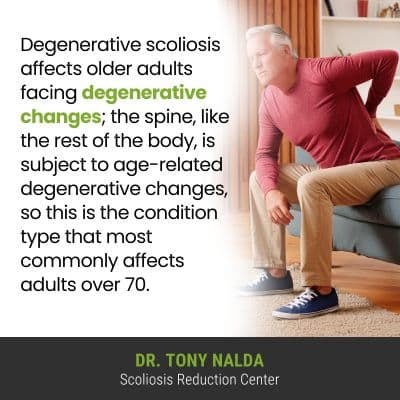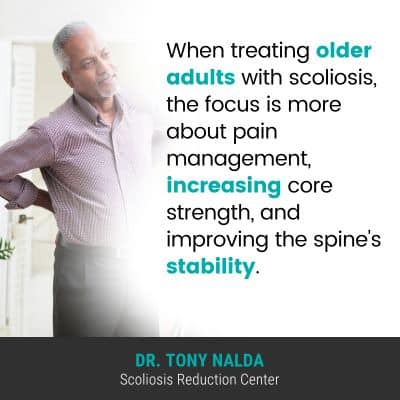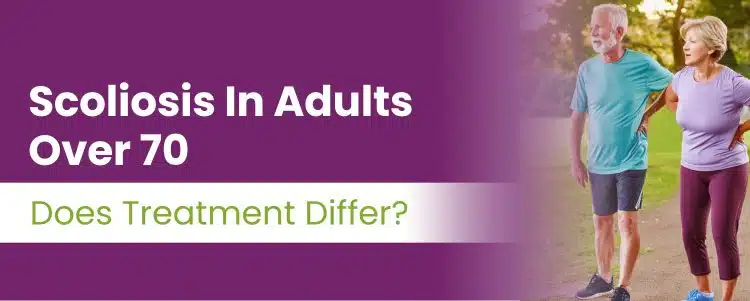When treating childhood scoliosis versus adults and older adults, the focus is different; while scoliosis is still progressive in adulthood, the rate tends to slow because it’s growth that triggers progression. Also, adult scoliosis is compressive so has to have a pain management focus. For adults over 70, spinal degeneration can make the spine increasingly unstable.
Adults over the age of 70 are most commonly affected by degenerative scoliosis. Treatment differs when treating adults because scoliosis becomes a compressive condition once skeletal maturity has been reached and the progressive trigger of growth is no longer a factor.
Before getting to the specifics of how to treat scoliosis in adults over 70, let’s first talk generally about how and why the focus of treatment differs from children to adults with scoliosis.
Adult Scoliosis Versus Childhood Scoliosis
No two cases of scoliosis are the same; the complex nature of scoliosis necessitates the complete customization of treatment plans.
When it comes to experiencing life with scoliosis, patient age is an important factor because as a progressive condition triggered by growth, growth spurts cause the condition to become worse over time, and when it comes to adult scoliosis, spinal degeneration comes into play.
So children are more at risk for rapid progression than adults because they have more growth to go through prior to reaching skeletal maturity, and once skeletal maturity is reached, scoliosis becomes a compressive condition, and when this happens, scoliosis can become a painful condition.
In children, the main scoliosis effects involve postural changes, but in adults, it’s pain.
Not only does scoliosis range widely in severity from mild scoliosis to moderate scoliosis and severe to very severe scoliosis, there are also different types a person can develop.
Approximately 80 percent of known diagnosed cases are idiopathic scoliosis, meaning not clearly associated with a single-known cause, and the remaining 20 percent consist of types with known causes: neuromuscular scoliosis, congenital scoliosis, and degenerative scoliosis.
So the two main ways that adult and childhood scoliosis treatment differ is in progression and compression: how fast a patient’s condition gets worse and how painful it is.
Adult Scoliosis
Scoliosis is more commonly diagnosed in children, but the condition also affects adults, and the actual rate of scoliosis increases with age, and this is due to degenerative scoliosis.
The most common occurrence of scoliosis in adults involves idiopathic scoliosis, and these cases involve adult patients who had scoliosis during adolescence, but were unaware, so their conditions were neither diagnosed nor treated while young; this is a common scenario that adults with scoliosis don’t notice the condition until skeletal maturity caused the condition to become compressive and painful.
Particularly in cases of mild adolescent idiopathic scoliosis, as the condition isn’t compressive and painful, and isn’t known to cause functional deficits, it’s not always noticeable, and when mild, postural changes in children can also be subtle.
After idiopathic scoliosis, the most common type of scoliosis to affect adults, particularly adults over the age of 50, is degenerative scoliosis.
Degenerative Scoliosis

Degenerative scoliosis is more common in females due to changes in bone density and hormones caused by menopause and is also known as de novo scoliosis (no prior history with the condition).
Degenerative scoliosis affects older adults facing degenerative changes; the spine, like the rest of the body, is subject to age-related degenerative changes, so this is the condition type that most commonly affects adults over 70.
When it comes to spinal degeneration, it’s most often the intervertebral discs that are the first spinal structures to start to deteriorate, and this is partly because they don’t have their own vascular supply, and also because of the many important roles they play in maintaining spinal health and function.
The spine consists of vertebrae (bones) stacked on top of one another, and adjacent vertebrae are separated by an intervertebral disc.
The discs give the spine structure (adjacent vertebral bodies attach to the disc in between) and flexibility, and they also provide cushioning so vertebrae don’t rub up against one another, creating friction during movement.
The discs also act as the spine’s shock absorbers to ensure mechanical stress is evenly distributed and absorbed throughout the spine.
Degenerative disc disease is a contributing factor in the development of a number of spinal conditions, and asymmetric degeneration can make an older adult’s spine increasingly unbalanced, unstable, and unable to maintain its healthy curves and alignment.
Once a disc starts to degenerate and/or is damaged, it can be difficult, if not impossible, to reverse the damage; the discs are the largest structures inside the body that don’t have their own vascular supply, and this can make repair and restoration a challenge.
When we’re talking about adults over 70, we are mainly referencing adults with degenerative scoliosis, caused by natural age-related spinal degeneration, along with the cumulative effect of certain lifestyle factors.
Treating Older Adults with Scoliosis

The ultimate goal of treatment for patients of any age is to improve their overall quality of life, and to me, a modern conservative scoliosis treatment approach is best for spinal health and function, and this is what my patients benefit from here at the Scoliosis Reduction Center®.
So when treating children with scoliosis, a major focus of treatment is working towards a significant curvature reduction, and holding the reduction during growth: counteracting the condition’s progressive nature.
When treating older adults with scoliosis, the focus is more about pain management, increasing core strength, and improving the spine’s stability.
Progression
Once skeletal maturity has been reached in adulthood, the progressive trigger of growth is no longer occurring, so the rate of progression is commonly slower in adults, but adult scoliosis does still progress, and in older adults, once the spine starts to degenerate, scoliosis can progress faster.
In fact, the actual rate of scoliosis increases with age; it’s estimated that around 2 to 4 percent of adolescents are affected by scoliosis, while studies show that approximately 12 to 20 percent of adults over 60 are affected by scoliosis, with some studies finding rates as high as 68 percent.
Pain
When it comes to pain, this isn’t considered a common symptom of childhood scoliosis because the condition isn’t yet compressive; its compression (uneven pressure) of the spine and its surrounding muscles and nerves that causes the majority of condition-related pain.
Prior to reaching skeletal maturity, the spine is experiencing a constant lengthening motion that counteracts the compressive force of the unnatural spinal curve, but once growth stops, there is nowhere for that compression to go, and it commonly becomes painful.
Scoliosis pain can involve muscle pain, back pain, and pain that radiates into the extremities due to nerve compression.
Increasing levels of pain are common alongside compression and increasing degenerative changes, and as a scoliotic spine becomes more unbalanced and unstable, it’s weaker, more vulnerable to injury, and more painful.
While there are pain medications that can help, a variety of therapies can also be recommended to provide relief, but the best remedy for long-term sustainable pain management and relief is proactive treatment that addresses the underlying structural nature of scoliosis.
Reducing the Curve
While trying to work towards a significant curvature reduction is the goal when addressing adolescent idiopathic scoliosis, working towards reducing an elderly individual’s curve back to where it was prior to becoming painful is the goal of degenerative scoliosis treatment.
Curvature reductions are worked towards through condition-specific chiropractic care, and this can involve a series of techniques and gentle and precise manual adjustments that can reposition the curve’s most-tilted vertebrae back into alignment with the rest of the spine.
Making the Back Muscles Stronger
Physical therapy can also help with increasing core strength so the spine can receive more support and stabilization from its surrounding muscles, and this can easily be modified to suit an older patient’s ability.
It’s not just the spine that has to maintain its natural curves and alignment, but also the spine’s surrounding muscles.
Physical therapy and the prescription of scoliosis-specific exercises and stretches can also help address any muscular imbalance (a common occurrence in people with scoliosis) caused by the unnatural spinal curve pulling its surrounding muscles in different directions.
Physical therapy can also help aging adults improve their posture and body positioning, while activating certain areas of the brain for improved brain-body communication.
Scoliosis Bracing
Corrective bracing can be a powerful facet of a conservative treatment approach; for young patients, corrective bracing is about augmenting large curvature reductions that can counteract growth, but in older adults, it’s more commonly used for short-term pain relief and to stabilize the spine.
Rehabilitation
Rehabilitation is important for patients of all ages so treatment results can be sustained, and this can involve continued chiropractic care and the prescription of custom scoliosis-specific exercises to further heal and stabilize the spine.
Conclusion
The older an adult gets, the more risky spinal surgery is, and for those on the path of traditional scoliosis treatment, surgery is a common recommendation, and this involves spinal fusion: an expensive, lengthy, and invasive spinal surgery that can cost the spine in a number of ways.
If orthopedic surgery fails, at any age, the only recourse is more surgery, and once a spine is fused, it’s fused for life, and the risks and potential complications increase with age and each subsequent spinal surgery; this isn’t ideal for elderly patients whose spines are already weak, unbalanced, and unstable, and this is why the elderly population have the highest rate of scoliosis.
Surgical outcomes don’t always offer the best results, and the proven results of conservative treatment show that not all scoliosis patients have to become surgical patients.
Here at the Center, I believe in the power of a more natural proactive treatment approach that involves conservatively treating scoliosis through the application of a number of scoliosis-specific treatment disciplines.
A benefit of this approach is that treatment plans are always customized to suit the individual, so plans can easily be modified, and/or treatment disciplines adjusted accordingly, based on a patient’s age and ability.
The two main types of scoliosis to affect adults are idiopathic scoliosis and adult-onset scoliosis, also known as de novo scoliosis and/or degenerative scoliosis, and while there are never treatment guarantees, conservative treatment offers a minimally invasive treatment option that can improve an elderly patient’s overall quality of life, while preserving as much of the spine’s natural strength and function as possible.




